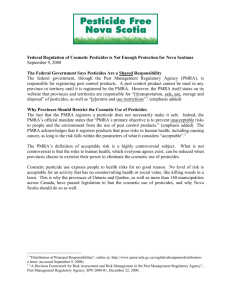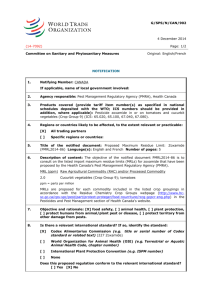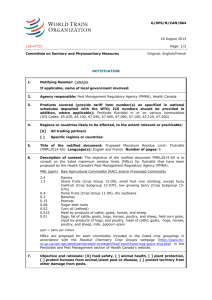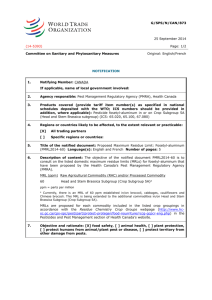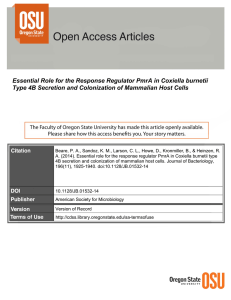Federal Regulation of Pest Control Products For Use in Aquaculture
advertisement
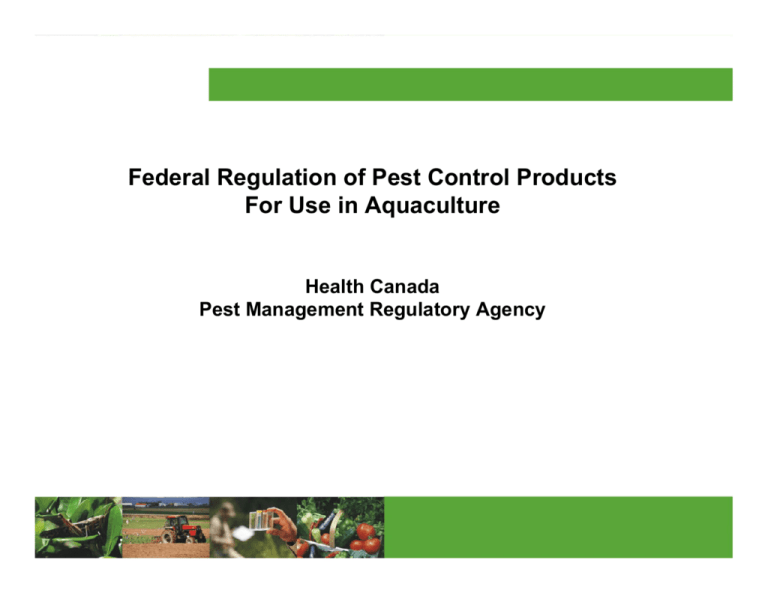
Federal Regulation of Pest Control Products For Use in Aquaculture Health Canada Pest Management Regulatory Agency Outline • • • • PMRA responsibilities related to aquaculture PMRA Regulatory Process Environmental Assessment Approach Compliance and Enforcement of Pest Control Products Act (PCPA) 2 Pesticide Regulation and Aquaculture • • Products which are applied to water or topically applied to animals or structures used in aquaculture for pest control purposes are considered pesticides and are covered under the PCPA. Products which are administered in feed or injected into animals are considered Veterinary Drugs and are covered under the Food and Drugs Act (FDA) and the Canadian Environmental Protection Act (CEPA). 3 Pest Management Regulatory Agency Branch of Health Canada Role: Federal Regulation of pest control products Responsibility: Administration of the Pest Control Products Act which regulates the sale, manufacture, use and importation of pest control products Mission/Mandate: Protect the health and environment of Canadians and support Canadian competiveness by regulating pesticides and their use in an effective and transparent manner 4 Pesticide Regulation in Canada: Distribution of Legislative Responsibilities Federal • Regulation of New Pesticides • Re-evaluation of Existing Products • Compliance and Enforcement of PCPA Provincial • • • • Transportation, sale, use, storage and disposal Training, certification and licensing Further restrictions/conditions on use Compliance and Enforcement Activities 5 Regulatory Process • For pesticides to be used or imported to in Canada, they must be registered • The registration process requires that : • Applicants must submit data required by the Minister • Submissions undergo a pre-market science based risk assessment • Risks from proposed uses to human health, the environment and value must be acceptable • The Minister establishes the conditions of registration 6 Federal Regulatory Mechanisms to Enable the Sales/Use of Pesticides in Canada • Research Authorizations - can be granted to conduct research related activities with pest control products • Registration of technical actives and end-use products • Emergency Registration 7 Registration of a Pesticide • • Decision of the federal Minister of Health Based on acceptable risk: • Reasonable certainty of no harm to health, future generations and the environment from use or exposure when used according to label directions • Requires public consultation for regulatory decisions on new actives or major new uses • done on line via PMRA Public Registry • Registration enables the sales/use of a pesticide in Canada • Allows use under conditions of registration as specified on the label. Use in a manner not specified is illegal 8 Emergency Registration Sponsor: Province or Federal Department/Agency involved in direct management of the pest problem • Criteria: Pest outbreak occurs that can cause significant economic, environmental or health problems; No effective product or application method registered in Canada for the control of the pest; and, No effective alternative control method available. Technical active already registered for use in Canada • • Registration granted for up to one year Conditions & Restrictions may be applied 9 Science Based Risk Assessments • Data requirements are determined by PMRA to allow characterization and identification of potential risks • Health Evaluation: toxicology and epidemiology; occupational and bystander; dietary exposure • Environmental Assessment: environmental toxicology, environmental chemistry and fate (including persistence and bioaccumulation) • Value Assessment: efficacy, sustainability competitiveness • These form key inputs to risk management and regulatory decision 10 Environmental Risk Assessment Framework Hazard Assessment Exposure Assessment Environmental Chemistry Use Pattern Acute and Chronic Toxicity Bioaccumulation Risk Characterization Integration of Exposure and Effects Identify environmental concerns Risk Management - Risk Mitigation Options 11 Response Key Concepts - Dose Response Dose 12 Key Concepts - Toxicity (hazard) • Measures of toxicity are a function of two factors: • Dose (how much) • Duration (how long) • • • The shorter the exposure, the greater the dose needed to get an effect Results of toxicity tests expressed as a concentration and exposure period (eg. 48h LC50) Also related to a particular exposure media (eg seawater, sediment, etc) 13 Key Concepts - Risk • • • • • • Risk is a function of both hazard (toxicity) and exposure Most chemicals have the potential to cause adverse effects at high enough doses but there is usually a dose – a low enough exposure - below which no effects will occur Generally, as the amount of exposure increases, so does the risk of effects This is why risk assessments put such a strong emphasis on estimating both the amount and duration of exposures Risk assessments match up what we know about hazard with how exposure is expected to occur Used to identify potential concerns and risks 14 Key Concepts - Risk Hazard Exposure Risk Receptor 15 Risk Mitigation • Measure(s) which can be used to limit exposure will help decrease risk • No or limited exposure no or limited potential for effects • Conditions/restrictions for registrations • • • • • • Application rates Frequency of application Timing of application Method of application PPE Type of Product Registration (eg: Restricted) 16 HC - PMRA Compliance and Enforcement • • • • PMRA’s Compliance and Enforcement Program supports the Agency’s primary objective of protecting the health of Canadians and their environment from unacceptable risks associated with the use of pest control products. National Program with Regional Inspection Staff Regionally based Staff According to the PCPA and its regulations: • All products must be registered prior to – Import – Sale – Use • All registered products must be used according to approved labelled uses and conditions HC - PMRA Compliance and Enforcement Compliance Activities: Compliance Promotion, Monitoring Inspections and Compliance Verification/Surveillance Inspections. Enforcement is any action that is taken to induce, encourage or compel compliance. Options that are available include: • education letter; • administrative monetary penalty (AMP) or warning; • compliance order • prosecution; • amend, suspend or cancel registration; • voluntary recall; • seizure and detention; • seizure and forfeiture; and • denial of entry into Canada. HC - PMRA Compliance and Enforcement • • The PMRA generally follows an established conformity continuum used by many compliance and enforcement officials. This continuum ranges from conformity through education to responses to situations of non-compliance. The PMRA considers whether there is knowledge/understanding, intent and the ability to comply with regulatory requirements. The following factors are also considered: – the history of compliance, evidence of corrective action already taken; – the degree of actual harm or potential harm as a result of noncompliance; and – the level of response necessary to achieve and maintain continuing compliance. 19 Fines under the PCPA • • In regards to AMPs the maximum fine is up to $6000 per violation In regards to disobeying compliance orders the liability is as follows: • • • a) "on summary conviction, to a fine of not more than $200,000 or to imprisonment for a term of not more than six months, or to both; or b) "on conviction on indictment, to a fine of not more than $500,000 or to imprisonment for a term of not more than three years, or to both The above liability applies to all offences except where wilfulness or recklessness lead to a risk of imminent death or serious bodily harm to another person, risk of substantial harm to the environment or harm to the environment in which case the liability is: • • a) not more than $300,000/six months or both for summary conviction or b) not more than $1,000,000/3 years or both as detailed in s.68(4) PCPA. 20 Collaborative Effort HC - PMRA works in collaboration with its partners responsible for the environment and aquaculture/fisheries to: • • • • • Maximize efficiency and inspection coverage for use of products. Execute salmon-farm inspection blitzes. Analyze salmon samples in conjunction with Environment Canada sampling program. Work cooperatively with all partners to examine and respond to potential non-compliance issues. Be aware of industry treatment and regulatory inspection strategies and emerging issues. Useful Links: • Pest Control Products Act Link to PCPA • PMRA Website http://www.hc-sc.gc.ca/pmra •Regulatory Data Requirements for Aquaculture Data Requirements I Data Requirements II •PMRA Public Registry Public Registry •PMRA Consultations Consultations 22 For Further Information: E-mail: pmra.infoserv@hc-sc.gc.ca Telephone: 613-736-3799 Toll-free: 1-800-267-6315 Facsimile: 613-736-3798 23
